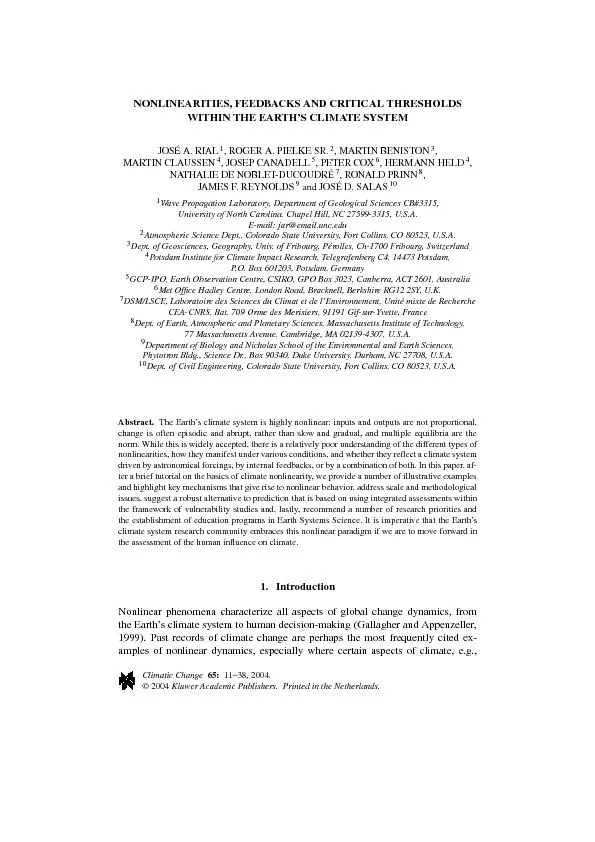/


ClimaticChange11 ID: 418062
Download Pdf The PPT/PDF document "NONLINEARITIES,FEEDBACKSANDCRITICALTHRES..." is the property of its rightful owner. Permission is granted to download and print the materials on this web site for personal, non-commercial use only, and to display it on your personal computer provided you do not modify the materials and that you retain all copyright notices contained in the materials. By downloading content from our website, you accept the terms of this agreement.
NONLINEARITIES,FEEDBACKSANDCRITICALTHRESHOLDSWITHINTHEEARTHSCLIMATESYSTEMJOSÉA.RIAL,ROGERA.PIELKESR.,MARTINBENISTONMARTINCLAUSSEN,JOSEPCANADELL,PETERCOX,HERMANNHELDNATHALIEDENOBLET-DUCOUDRÉ,RONALDPRINN ClimaticChange1138,2004.©2004KluwerAcademicPublishers.PrintedintheNetherlands. JOSÉA.RIALETAL.thethermohalinecirculationoftheNorthAtlanticocean,suggesttheexistenceofthresholds,multipleequilibria,andotherfeaturesthatmayresultinepisodesofrapidchange(StockerandSchmittner,1997).AsdescribedinKabatetal.(2003),theEarthsclimatesystemincludesthenaturalspheres(e.g.,atmosphere,biosphere,hydrosphereandgeosphere),theanthrosphere(e.g.,economy,society,culture),andtheircomplexinteractions(Schellnhuber,1998).Theseinteractionsarethemainsourceofnonlinearbehavior,andthusoneofthemainsourcesofuncertaintyinourattemptstopredicttheeffectsofglobalenvironmentalchange.Insharpcontrasttofamiliarlinearphysicalprocesses,nonlinearbehaviorintheclimateresultsinhighlydiverse,usuallysurprisingandoftencounterintuitiveob-servations,soitisimportant,beforeembarkingonthediscussionofdata,thatweagreeonafewbasiccharacteristicsofnonlinearclimate.1.1.LINEARANDNONLINEARSYSTEMSEvenanelementarydescriptionofEarthsclimatesystemmustdealwiththefactthatitiscomposedoftheabovesubsystemsallinterconnectedandopen,allowing uxesofmass,energyandmomentumfromandtoeachother(seeFigure1).SincetheEarthitselfisaclosedsystem,these uxeseventuallycyclethrough,sothatoutputsre-enterthesystemtobecomeinputs,creatingfeedbacksandfeedbackchains.Eventually,eachsubsystemaffectstheresponseofeveryothersubsystemandoftheclimateasawhole.Itisthiscrosstalkamongthedifferentpartsoftheclimatethatengendersthedisproportionaterelationsbetweeninputandoutputtypicalofanonlinearsystem.Thephrasethewholeismorethanthesumofitspartsunderscoresthefailureoftheprincipleofsuperpositioninanonlinearsystemsuchastheclimate.Insharpcontrast,wheresuperpositionisvalidthewholeisexactlyequaltothesumofitsparts.Thesystemislinearandthereisnocrosstalk;eachpartbehavesasifitwereactingalone.Howdowetellwhenthereisnonlinearityintheclimateweobserve?Thereareatleastthreeimportantobservablecharacteristicsthatseparatelinearfromnonlinearsystems,allofwhichareexempli edinthedatatobediscussed.(1)Whilelinearsystemstypicallyshowsmooth,regularmotioninspaceandtimethatcanbedescribedintermsofwell-behaved,continuousfunctions,nonlin-earsystemsoftenundergosharptransitions,eveninthepresenceofsteadyforcing.Thesetransitionsusuallyresultfromcrossingunstableequilibriumthresholds(e.g.,abruptclimatechange,asdescribedbyAlleyetal.,2003).(2)Theresponseofalinearsystemtosmallchangesinitsparametersortochangesinexternalforcingisusuallysmoothandproportionatetothestimulation.Incontrast,nonlinearsystemsaresuchthataverysmallchangeinsomeparameterscancausegreatqualitativedifferencesintheresultingbehavior(chaos)assug-gestedforinstanceby uiddynamicmodelsofatmosphericconvection(Lorenz, NONLINEARITIES,FEEDBACKSANDCRITICALTHRESHOLDS Figure1.StructureofCLIMBER-2,anEarthSystemModelofIntermediateComplexity(EMIC;Claussenetal.,2002).Themodelconsistsoffourmoduleswhichdescribethedynamicsoftheclimatecomponentsatmosphere,ocean,terrestrialvegetation,andinlandice.Thesecomponentsinteractvia uxesofenergy,momentum(e.g.,windstressontheocean),water(e.g.,precipitation,snow,andevaporation),andcarbon.Also,theland-surfacestructureisallowedtochangeinthecaseofchangesinvegetationcoverortheemergenceandmeltingofinlandicemasses,forexample.Theinteractionbetweenclimatecomponentsisdescribedinaso-calledSoilVegetationAtmosphereTransferScheme(SVAT).CLIMBER-2isdrivenbyinsolation(whichcanvaryowingtochangesintheEarthorbitorinthesolarenergy ux),bythegeothermalheat ux(whichisverysmall,butimportantinthelongrunforinlandicedynamics),andbychangesimposedontheclimatesystembyhumanactivities(suchaslanduseoremissionofgreenhousegases(GHG)andaerosols).(3)Aftertransientsdissipate,anoscillatorylinearsystemsfrequencyalwaysequalsthatoftheforcing,whilethespectralresponseofanonlinearsystemtooscillatoryexternalforcingusuallyexhibitsfrequenciesnotpresentintheforcing(suchascombinationtones),phaseandfrequencycoupling,synchronizationandotherindicationsofnonlinearityoftendetectedinpastclimatedata(e.g.,Pisiasetal.,1990).1.2.CHAOSANDCOMPLEXITYThus,nonlinearitygivesrisetounexpectedstructuresandeventsintheformofabrupttransitionsacrossthresholds,unexpectedoscillations,andchaos(KaplanandGlass,1995).Actually,theclimatesystemisnotonlychaotic,itisalsocomplex(Rind,1999),inthesensethatitiscomposedofmanypartswhose JOSÉA.RIALETAL.interactionscan,throughaprocessstillnotcompletelyunderstood(Cowanetal.,1999),provokespontaneousself-organizationandtheemergenceofcoherent,col-lectivephenomenathatcanbedescribedonlyathigherlevelsthanthoseoftheindividualparts(GoldenfeldandKadanoff,1999).Therefore,itisusefultoestab-lishforclarityssakethatchaosandcomplexityaredifferentaspectsofnonlinearresponse.Chaosreferstosimplesystemsthatexhibitcomplicatedbehavior,suchastheintricatetimeseriesproducedbyadrippingfaucet,theunpredictableoscil-lationsofadoublependulum,ortherandombehaviorofpopulationsinmodelsoflogisticgrowth(May,1976).Conversely,complexityreferstocomplicatedsystemsthatexhibitsimple,so-calledemergentbehavior.Forinstance,inthehighlycom-plextectonic-geologicsubsystem,theemergentbehaviorisanearthquake,intheworldeconomy,astockmarketcrash,andinthebiosphere,amassiveextinction.Intheclimatesystem,abruptclimatechangeisalikelyexampleofunpredictableemergentbehavior.Infact,observationsindicatethattheclimatesystemis,andhasbeenformillionsofyears,riddledwithepisodesofabruptchange,rangingformlarge,suddenglobalwarmingepisodes(e.g.,theendofthelasticeage),todrasticandrapidregionalchangesinthehydroclimaticcycle,precipitationandaridity(e.g.,theexpansionoftheSahara).Becauseoftheirobviousimportanceinunderstandingfutureclimatetrends,theseandotherexamplesofabruptclimatechangearediscussedinthispaper.Withintheclimatesystemchaoticbehaviorexhibitssensitivedependencetoinitialconditions,con nementandtypicalaperiodicity.Thisistosaythattinydif-ferencesininitialstatescanexponentiallyblowuptobigdifferencesinlaterstates,butthevaluesoftherelevantvariablesremaincon nedwithin xedboundaries,neverexactlyrepeating.Intheclimatesystem,andasweshallsoondiscuss,plau-sibleexamplesofchaosareENSO(ElNiño,SouthernOscillation)andNAO(NorthAtlanticOscillation).Infact,simpledeterministicmodelsthatexhibitchaoticbehaviorqualitativelyreproducetheirregularoscillationsofENSOforstrongcou-plingbetweenoceanandatmosphere(e.g.,Tzipermanetal.,1994).ENSOmayinfactbechaoticinthesensethattheequatorialPaci cclimatemay ipinachaoticway(randomly)fromonetoanotherofitsthreepreferredquasi-stablestates(normal,LaNiña,ElNiño).1.3.FEEDBACKSANDTHRESHOLDSAlthoughchaoticdynamicsandemergentpropertiesmaybesurmisedfromdatainterpretationandfromthecomparisonofdatatomodels,feedbacksaretheonlyclimateprocesseswhosepresenceandeffectscanoftenbequanti edand,insomecasesunderstoodwithalmostcertainty.Inthispaperweillustratehowthepresenceofseveraltypesofamplifying(positive)andcontrolling(negative)feedbacks,somephysical(icesheet-albedointeraction),somebiogeophysical(albedo-vegetationin-teraction),andsomebiogeochemical(anthropogenicgases-atmosphereinteraction)canbededucedfromobservations.Feedbacksarethemostlikelyprocessesbehind NONLINEARITIES,FEEDBACKSANDCRITICALTHRESHOLDSmostofthenonlinearitiesintheclimate.Therelativelystableglobaltemperatureandbenignclimatetheearthhasenjoyedforbillionsofyearsistestimonytotheactionofregulatingnegativefeedbackswhichbalanceandneutralizeamplifying(explosive)positivefeedbackscontinuously(e.g.,WatsonandLovelock,1984).ItisquitelikelythatsuchacontinuouslyactiveregulatingfeedbackmechanismfailedtodevelopinVenus,leadingtothepresenthellishenvironmentofitssurface.WecanthenimaginethatnaturehasarrangedthingsinsuchwaythatonEarth,andontheaverage,thenetclimate-drivingfeedbackisnegative,slightlystrongerthanthenetpositivefeedback,atleastforsmallvaluesofsome(externalorinternal)forcing.Itiswhentheforcinggrowstoapointinwhichthepositivefeedbacktakesoverthatitsexplosiveampli cationproducesthenonlineareffectsthatweseeinthedata.Thus,acriticalthresholdmayinfactbethepointatwhichthetwocom-petingfeedbackeffectsarejustbalanced.Sincetherearecountlessfeedbacksandthresholds,rapidampli cationofpotentiallyexplodingvariablesbecomeshighlyprobable,andsharp,abruptclimatechangeshouldthenbethenorm,asappearstobesuggestedbythepastrecordsofclimatechange.Wemustemphasizehoweverthatthereisasyetnobasicunderstandingofabruptclimatechange(Clarketal.,1.4.PAPERORGANIZATIONThegoalofthispaperistodiscusskeyissuesandquestionsrelatedtononlinearityintheEarthsclimatesystemanditsimplicationsinglobalclimatechangeresearch.First,wediscussexamplesofnonlinearclimateresponsefromobservationsofabruptclimatechangedetectedinbothpre-historicandrecenttimeseries(Exam-ples2.12.5).Nextwediscussmodelsofcoupledoceanandatmospheremediatedbychaoticdynamics(Examples3.13.2).Finallywelookatnonlinearitiesinthecarboncycleandtheeffectsofbiogeochemicalfeedbacksinmodelsofpresentandfutureclimatechange(Examples4.14.4).Aftertheexamples,weaddressscaleandmethodologicalissuesasrelatedtosomeofthechallengesinpredictingtheconsequencesofhumanactionsontheEarthsclimatesystem.Forexample,giventhenearlycertainoccurrenceofsuddentransitionsbetweenclimatestates,ispredictionperseachievable?Wesuggestanalternativeandhighlyrobustapproachusingintegratedassessmentswithintheframeworkofvulnerabilitystudies,thedetailsofwhichwethendiscussandjustify.Toconcludeweprovideaseriesofrecommendationsforresearchpriorities,includingelucidatingpotentialsourcesofnonlinearity,identifyingkeyfeedbacksandlinkagesintheEarthsclimatesystem,andestablishingEarthSystemsScienceprogramsinordertoprovidethenextgenerationofscientistsamorecompleteviewonthiscrucialtopic. JOSÉA.RIALETAL.2.Nonlinearity,AbruptClimateChangeandFeedbacksinPastandPresentClimateTimeSeries2.1.THENONLINEARPACEMAKEROFTHEICEAGESNaturehasbeenperformingclimateexperimentsformillionsofyears,andmanyoftheresultsarerecordedindeep-seasedimentsandicecores(e.g.,Cronin,1999).Itisthereforeimportantthatwebeginourdiscussiondescribingpaleoclimatedatatoprovideahistoricalperspective.Asweshallsee,thepaleoclimaterecordssuggestastronglynonlinear,complexclimatesystem.TheiceagesofthePleistoceneareremarkablequasi-periodiceventsofpastglobalclimatechange.Attheirpeakglobalmeantemperaturewasover4Clowerthantoday,andenormousicesheetsseveralkilometersthickcoveredmostofnorth-ernNorthAmericaandEurasia.However,therecordsoftheiceagesarefarfromunderstood,mostlybecausetheresponseoftheclimatetothepresumedforcing(secularchangesinEarthsorbitaleccentricity,spinaxis,andprecession)appearstobestronglynonlinear.Forinstance,itiswellknownthatwhilethemaindrivingfrequencyoftheiceagesisabout100ky(1ky=1,000years)thetimingbetweenconsecutiveglacialperiodshasbeensteadilyincreasingfrom80kyto120kyoverthelast500ky(Raymo,1997;Petitetal.,1999).Thisfeature,plusthenearabsenceofalargeresponseatthestrongesteccentricityforcingperiod(413ky)andthepresenceofsigni cantvarianceatfrequenciesnotpresentintheorbitalforcing,arestrongevidenceofnonlinearityintheclimatesresponsetoorbitalforcing(e.g.,Nobesetal.,1991;Ghil,1994).Toexplainthesenonlinearfeatures,Rial(1999)introducedtheideathattheclimatesystemtransformstheastronomicallyamplitude-modulatedinsolationintofrequencymodulated uctuationsofglobalicemass.Thisisfrequencymodulationentirelyanalogoustotheelectronicprocessbywhichthefrequencyofacarriersignalischangedinproportiontotheamplitudeofarelativelylowerfrequencysignal,asinFMradioandtelevisionbroadcasting.Manywell-knownpropertiesofFMsignalsareinfactfullyconsistentwithfea-turesofthepaleoclimatedatathathavepuzzledresearchersforyears,suchastheabovementionedvaryingdurationoftheiceagecycle,thepresenceofcombinationtonesoforbitalfrequencies,andperhapsthemosttelling,theapparentabsenceofspectralpowerat413ky(Imbrieetal.,1993).Frequencymodulationisaphase-andfrequency-lockingprocessthattransfersenergyfromonefrequencybandintoanother,andcreatesnewfrequencies(calledsidebands)ascombinationtonesofthecarrierandthemodulatingfrequencies,andthusagoodexampleofnonlinearcrosstalkamongthefrequenciesthatmakeuptheresponse. NONLINEARITIES,FEEDBACKSANDCRITICALTHRESHOLDS2.2.THEMIDPLEISTOCENECLIMATESWITCHAround950kyago,aprominentswitchinthefrequencyresponseofthecli-matesystemtoorbitalforcingoccurred.Thisphenomenon,usuallycalledthemid-Pleistocenetransition(MPT),resultedinachangefromthe41kypredomi-nantglaciationperiodtoanew100kyperiod,withoutacorrespondingchangeintheforcingorbitalfrequencies,asshowninFigure2a.Thoughanumberofexplanationshavebeenproposed,theMPTcontinuestobeoneofthemostpuz-zlingexamplesofthenonlinearcharacterofclimateresponse.Figure2aclearlyshowsthattheoscillatoryresponseoftheclimateswitchesfrequencyandampli-tudeatabout950kyagowhiletheforcingisessentiallythesamethroughout.MudelseeandSchulz(1997)estimatetheicemasstohaveincreasedbyaboutkg,equivalenttoanicesheetareaexpansionof3andthicknessofupto3km.Suchalargeincreaseiniceextent(andicetopog-raphy)musthavecreatedanewatmosphericcirculationpatternandnewfeedbackstomaintainthenew,unprecedentedclimaticconditions(longerglaciationsandgreater,thickericecaps).AprobablecluetotheoriginoftheMPTisthefactthataroundonemillionyearsagothemeanlong-termtrendoftheinsolationdroppedslightlytoanewmean(BergerandLoutre,1991).Thecorrespondingdecreaseinmeanglobaltemperature,ampli edbyfeedbacks,couldhaveshiftedtheclimatesystemssensitivitytoforcingatlowerfrequency.Thetransformationofameantemperaturestep-likedropintoaswitchtoamuchlowerresonantfrequencyisaclearexampleofnonlinearresponse,consistentwiththepreviouslymentionedtransformationofamplitudemodulationintofrequencymodulation.2.3.ABRUPTWARMINGEPISODESINTHEPALEOCLIMATERECORDPaleoclimaterecordsovermanytimescalesexhibitepisodesofrapid,abruptcli-matechange,whichmaybede nedassuddenclimatetransitionsoccurringatratesfasterthantheirknownorsuspectedcause(Rahmstorf,2001).Abruptcli-matechangeisbelievedtobetheresultofinstabilities,thresholdcrossingsandothertypesofnonlinearbehavioroftheglobalclimatesystem(Clarketal.,1999;Alleyetal.,1999;Rahmstorf,2000),butneitherthephysicalmechanismsinvolvednorthenatureofthenonlinearitiesthemselvesarewellunderstood.Figure2bshowsselectedexamplesofabruptclimatechangeintheformofrapidwarm-ingepisodesfollowedbymuchslowercoolingepisodes.Eachwarming/coolingsequenceusuallyrepeatsatnearlyequaltimeintervals,givingthetimeseriesacharacteristicquasi-periodicsaw-toothappearancethat,remarkably,appearsatmultipletimescales(asshownintheenlargement)anddisplaysanunclearrelationtoastronomicalforcing.Throughoutmostofthepaleoclimateproxydatafromsedimentsandicecores,thereisafrequentrepetitionofthissametheme;abruptandfastwarming(some-timeslastingonlyafewdecades)followedbymuchslowercooling.Thisisapatternthat,havinghappenedofteninthepast,willlikelyhappeninthefuture, JOSÉA.RIALETAL. Figure2a.Examplesofnonlinearitiesinthepaleoclimate.Themid-Pleistocenetransition(MPT).Theglobalicevolumeproxyshowsasuddenchangeinpredominantfrequencyaround950kyago.Thetoppanelshowsthedata(Site806),thenexttwopanelsshow(toptrace)theresultof lteringthedatawithanarrowband-pass ltercenteredat100kyandbelowitthecorrespondingastronomicalforcing(insolation) lteredinthesamemanner.Thelowertwopanelsshowasimilarcomparisonbutfora ltercenteredat41ky.Thelongerperiodrecordsre ecttheselectivenonlinearityofthesystem,astheresponseto100kyforcingisnegligiblefortimesearlierthan1Ma,andafterthatitbecomesstrong,withoutacorrespondingchangeintheforcing.Nosimilarrelationisseenintheshortperiods.(Modi edfromClarketal.,1999;MudelseeandSchulz,1997).whichmakescompellingevidencefortheurgentneedtoimproveourunderstand-ingofthephysicalprocessesinvolved.Byitself,Figure2balreadyprovokesanumberofobviousandstimulatingquestions,suchas,whyarewarmingepisodesgenerallysomuchfasterthancoolingones(saw-tooth)?Howcanrapidclimatechangebetriggeredbyslowchangeinorbitalparameters?Doesself-similarityofresponsemeansimilarityofprocessesregardlessoftimescale?Whatnonlinearprocessesareatwork?Couldthepresentrateofanthropogenicwarmingtriggeroneofthoseabrupt,hugewarmingeventsofthelasticeage?TheDansgaardOeschger(D/O)oscillationsofthelastglacialshowninFig-ures2band3aareamongtheclearestexamplesofabruptwarmingepisodes NONLINEARITIES,FEEDBACKSANDCRITICALTHRESHOLDS Figure2b.Samplesofclimatechangeacrossdifferenttimescalesandproxyrecords(stableisotopicratios)forglobaltemperatureandicevolume,includingSST(seasurfacetemperature)deep-seasediment(Site667)andicecores(Vostok,GRIP).Notethetypicalsaw-toothshapewhich,createdbythefastwarming/slowcoolingsequences,appearstobeindependentoftimescale,displayinganintriguingself-similarity.Mainwarmingperiodsareindicatedbyverticallightgraystripes.Also,notetheclosesimilaritybetweenthetemperatureoscillationsinGreenlandandinthesub-tropics(Bermuda)(datatakenfromRaymo,1997;GRIPProjectMembers,1993;Petitetal.,1999;SachsandLehman,1999).(regionaltemperatureinGreenlandincreasedsuddenlybyupto10Cinjustafewdecadesandonmultipleoccasions).Theclimatewasindeedhighlyvariableduringglacialtimesandswitchedabruptlyandfrequentlybetweencoldandwarmmodes.GanopolskiandRahmstorf(2001)proposedthefollowingmechanism.Thepresent-dayclimatestateischaracterizedbyawarm(switched-on)modeofthethermohalinecirculation(THC)beinginterpretedasanequilibriumstateoftheunderlyingdynamics.Althoughasecondstablestateexistsforthepresent-dayclimate(seeFigure3b)representingamodeleadingtomuchcoldertemperaturesovernorthernEurope(switched-offTHC),atransitionbetweenthetwohasnotoccurredduringtheHolocenebecauseoftherelativelylargebasinofattractionof JOSÉA.RIALETAL.thewarmmode.Quitethecontrary,duringthelastglacialperiod,astable(cold)andamarginallyunstable(warm)modeexistedforthedynamicsoftheTHCwithamuchsmallerbasinofattractionforthecoldmode.UtilizingCLIMBER2.3,aclimatemodelofintermediatecomplexity(whoseframeworkisillustratedinFigure1),itcanbeshownthatarelativelysmallperturbationofthefreshwaterinputathighlatitudesissuf cienttoswitchthesystemintothemarginallyun-stablemodewhoselifetimeisoftheorderofseveralhundredyears.AsinusoidalmodulationwithamplitudemuchsmallerthantheboundariesF1/F2inFigure3bdoesnotinduceswitchinginthepresent-dayclimatebutdoesresultinperiodicswitchingunderglacialconditions.Preliminaryresultsindicatethatinthepres-enceofnoise,thisdrivingamplitudecanbefurtherreduced,resultingina ippingbehaviortypicalofthenonlineareffectcalledstochasticresonance(GanopolskyandRahmstorf,2001).Finally,theD/Oeventscanbeexplainedifamildperiodicforcing(ofunknownorigin)oftheTHCplusnoiseisassumed.Thisexternaltriggerbecomesampli edduetothecoexistenceofastablestateandamarginallyunstablemodeintheTHCsystem.Suchcoexistenceisimpossibleinalinearsystem;hence,nonlinearityisanecessaryconditionforswitchingbehavior.2.4.THEABRUPTDESERTIFICATIONOFTHESPaleoclimaticreconstructionssuggestthatduringtheHoloceneclimateoptimum(90006000yearsago),NorthAfricawaswetterandtheSaharawasmuchsmallerthantoday(Prenticeetal.,2000).Annualgrassesandshrubscoveredthedesert,andtheSahelreachedasfaras23N(Claussenetal.,1999),over500kmnorthofitspresentlocation.DuringtheHoloceneoptimumaslightlyincreasedtiltoftheEarthsspinaxisandperihelioninJulyledtostrongerinsolationoftheNorth-ernHemisphereduringsummertherebystrengtheningtheNorthAfricansummermonsoon(KutzbachandGuetter,1986).However,theNorthAfricanclimateissensitivetochangesinlandsurfacesalbedo,whichcanresultfromvegetationremoval.Infact,CharneyandStone(1975)recognizedthathighalbedoresultingfromvegetationremovalcanenhancedesertexpansionbyreducingrainfall,whichfurtherreducesvegetation,inastrong,desert-expandingpositivebiogeophysicalfeedback.ThismechanismoffersapossibleexplanationforclimatechangesintheSaharaandparticularlyforincreaseddroughtintheSahelanditssouthwardmigrationinlateHolocene.Actually,whenusingpresent-dayland-coverasinitialcondition,modelsbasedsolelyonatmosphericprocessesdonotyieldanincreaseinprecipitationlargeenoughtoleadtoasubstantialreductionintheSahara6000yearsago(Joussaumeetal.,1999).However,whenfeedbacksbetweenatmosphereandvegetationareincorporated,themodelssimulateavegetationdistributioningoodagreementwithpaleobotanicreconstructions(ClaussenandGayler,1997;deNoblet-Ducoudreetal.,2000;Dohertyetal.,2000).Summarizing,precessionalforcingledtoanenhancementoftheAfricanmonsoon,creatingconditionsthatwerethenampli edmainlybyatmosphere-vegetationfeedbacks,andtoalesser NONLINEARITIES,FEEDBACKSANDCRITICALTHRESHOLDS Figure3a.Perhapsthemostpuzzlingfeatureofrecentpaleoclimaterecords,highlyrelevanttounder-standingfutureglobalclimatechange,isthefast-warming/slow-coolingsequencefoundinthestableisotope uctuations(O)timeseriesofGreenlandsicecoresknownastheDansgaard-Oeschger(D/O)oscillations(Jouzeletal.,1994;Alleyetal.,1999).TheD/Otypicallyshowverysudden,Cwarmingepisodeslastingafewcenturiesorperhapsevenafewdecades,followedbymillenniaofrelativelyslowcooling.Remarkably,reconstructedseasurfacetemperatures(SST)inthetropicalAtlantic(Figure2b)mimictheD/Orecordinthe30kato60kainterval,andsimilarrecordingsarefoundinthesubtropicalPaci candtropicalIndianoceans.Thelongestperiodofthesignalintheinsetisasubmultipleoftheprecessionforcingandevidenceofprecessionforcingexistselsewhereintherecord(Rial,2003).TheordinalsnearselectedpeakscorrespondtonumberedinterstadialsandYDistheYoungerDryasevent(Dansgaardetal.,1993). JOSÉA.RIALETAL. Figure3b.Climate(temperature)stabilityasafunctionoffreshwaterinputathighlatitudesintheNorthAtlantic(Modi edfromPaillard,2001).extentbyatmosphere-oceaninteraction(Ganopolskietal.,1998;Braconnotetal.,1999).Theseleadtomultipleequilibriumstates(Claussen,1997)withthepossibil-ityofabruptchangeswhenthresholdsarecrossed(Brovkinetal.,1998),asshowninFigure4(modi edfromClaussenetal.(1999)andDeMenocaletal.(2000)).This gureshowsamodelsimulationofanabruptdeclineinprecipitationintheSahara(20N30Nand15W50E)around5,500yearsagothatissupported NONLINEARITIES,FEEDBACKSANDCRITICALTHRESHOLDS Figure4.Simulationoftransientdevelopmentofprecipitation(B),andvegetationfraction(C)asresponsetochangesininsolation(Adepictsinsolationchangesonaverageoverthenorthernhemi-sphereduringborealsummer).ResultsfromClaussenetal.(1999)(B,C)arecomparedwithdataofterrigenousmaterialandestimated uxofmaterialinNorthAtlanticcoresofftheNorthAfricancoast(D)bydeMenocaletal.(2000).The gureisreproducedfromFigure2.8,inKabatetal.(2003),withpermission.byobservationsfromsedimentcoresofftheNorthAfricancoast.Therapidchangecontrastsmarkedlywiththeslowdecreaseininsolation.2.5.ABRUPTSHIFTSANDTRENDSOFHYDROCLIMATICTIMESERIESHereweillustrateabruptshiftsandtrendsofhydroclimatictimeseriesthatoccuratdecadaltimescales,ascomparedtohundredsandthousandsofyearsinthepreviousexamples.Theeffectofthesechangesontheenvironmentandsocietyareofcurrentconcernbecauseoftheiroccurrenceduringourlifetime.Anexampleofcomplextimeserieswithmultidecadaltrendsaretheannual owsoftheNiger JOSÉA.RIALETAL.RiveratKoulikoro(Figure5)andtheout owsfromtheAfricanequatoriallakes(Figure6).AsdepictedinFigure5,theNigerRiverseriesischaracterizedbyaslowdecayingautocorrelationfunction,re ectingalongmemory,yetthereareoccasionallargerapidshiftsintheannual ows.Sveinssonetal.(2003)showthatitispossibletosimulatestatisticallysimilartimeseriespatternsofstream owsthatmayoccurinthefuture,andanalyzethevulnerabilityofexistingandprojectedwatersupplysystemsinthisregion.Asevidentinthetimeseriesout owsfromtheequatoriallakesmeasuredattheMongallastationfortheperiod19151983(Figure6),itisnotnecessarytoemployanytypeofstatisticalanalysistorecognizethatsomethingpeculiarhappenedwiththeout owtimeseriesaround1962.Somehydrologistshavearguedthatsuchasuddenshiftintheout owmayhavebeentheresultofthelakesoperation(e.g.,Yevjevich,personalcommunication).However,others(e.g.,Lamb,1966,Figure1)havedocumentedthatLakeVictorialevelsalsoshowasimilarsuddenshiftduringthesametimeperiod.Furtheranalysisshowedthattheperiod19611964hasbeenthewettestconsecutiveperiodfortheentirehistoricalprecipitationrecord(Salasetal.,1981).Quitelikelynotonlyextremeprecipitationovertheequatoriallakes(e.g.,themajorwaterinputtoLakeVictoriaisfromprecipitationoverthelakeitself)butalsoincreasesinthecatchmentrunoffanddecreasesinthelakeevaporationandlandevaporation/transpiration(asare-sultofincreasedcloudinessofheavyrainyperiodsduringthesametimeperiod)mighthavecontributedtotheoccurrenceofsuchsigni cantandabruptshiftsintheEquatoriallakeslevelsandlakeout ows.3.NonlinearIrregularOscillationsandChaosinOcean-AtmosphereInteractions3.1.NORTHATLANTICOSCILLATIONANDELNIÑOSOUTHERNOSCILLATIONTheNorthAtlanticOscillation(NAO)isalarge-scalealternationofatmosphericpressure elds(i.e.,atmosphericmass)withcentersofactionneartheIcelandicLowandtheAzoresHigh.Whensea-levelpressureislowerthanaverageintheIce-landiclowpressurecenter,itishigherthanaverageneartheAzores,andvice-versa;whichcanbedescribedasasortofsee-sawoscillatingbehaviorofthesystem.LikeENSO(ElNiño/SouthernOscillation),theNAOrepresentsoneofthemostimportantmodesofdecadal-scalevariabilityoftheclimatesystem,andaccountsforupto50%ofsea-levelpressurevariabilityonbothsidesoftheAtlantic(Hurrell,1995).TheNAOexertsastrongin uenceonprecipitationandtemperatureonboththeeasternthirdofNorthAmericaandwesternhalfofEurope,particularlyduringwintermonths,andisresponsibleformanyclimaticanomalies(Beniston,1997;Hurrell,1995).TheNorthAtlanticOscillationindexiscomputedasadifferenceofsea-levelpressurebetweentheAzores(orLisbon,Portugal)andIceland.Itisameasure NONLINEARITIES,FEEDBACKSANDCRITICALTHRESHOLDS Figure5.Timeseriesofannualstream owsoftheNigerRiver,Africafortheperiod19071999showingacomplexpatternofhighandlow ows.Theautocorrelationfunctionshowstheeffectoflongmemory(modi edfromSveinssonetal.2003). Figure6.Timeseriesofannualout owsfromtheAfricanequatoriallakesmeasuredattheMongallastationfortheperiod19151983,showinganabruptshiftaround1961andslowdecayingdownwardtrend(adaptedfromSalasetal.(1981).Withpermission). JOSÉA.RIALETAL.ofthestrengthofzonal owsovertheNorthAtlantic.ApositiveanomalyoftheNAOindexrepresentsawarmphaseoftheoscillation,withdrierandwarmerthanaverageconditionsinthesouthernhalfofEurope.WhentheNAOindexisstronglypositive,thereisageneralreductioninatmosphericmoistureathighelevationsintheAlps(seee.g.,BenistonandJungo,2002).BecauseofthehighlypositivenatureoftheNAOindexinthelatterpartofthe20thcentury,itisspeculatedherethatasigni cantpartoftheobservedwarmingintheAlpsresultsfromshiftsintemperatureextremesinducedbythebehavioroftheNAO.Thesechangesarecapableofhavingprofoundimpactsonsnow,hydrology,andmountainvegetation.ENSOrepresentsanonlinearinterplayofcoupledocean-atmospherephenom-ena(e.g.,Tziperman,1994).ElNiñoisthewarmphaseofENSO,wherebyaweakeningoftheprevailingeasterlytradewindsintheequatorialPaci callowstheeastwardpropagationofwarmsurfacewaterthatnormallyaccumulatetothewestofthePaci cbasin.Associatedareasofdeepconvectionmigratewiththepropagationofthewarmsurfacewater,whicharetheprincipalenergysourceforconvection.TheareaofanomalouslywarmsurfacewateratthepeakofanElNiñoepisodecanreach30millionkm,roughly3timesthesizeofCanada,andcon-sequentlythesensibleandlatentheatexchangeattheocean-atmosphereinterfaceissuf cienttoperturbclimaticpatternsglobally.Thisperturbationoccursinthreesimultaneoussteps:verticaltransferofenergy,heatandmoisturethroughthedeepconvection,horizontalpropagationthroughatmospheric owsathighelevationsand,intime,anover owintothemid-latitudesynopticsystemsthatcanrein-forceorweakensurfacepressurepatternsandde ectthejetstreamsfromtheirusualtrajectories.ThecoldphaseofENSO,commonlyreferredtoasLaNiña,occurssometimes(butnotalways)attheendofanElNiñoevent.AnomalouslycoldwatersinvadethetropicalPaci cregion,andthestrengthofLaNiñacaninsomeinstancesreversethepreviouslydiscussedanomalypatterns,i.e.,byreversingrespectiveprecipitationordroughtpatternsthatoccurduringanElNiñoevent.FromamechanisticpointofviewENSOsirregularoscillationscanbeunder-stoodasthoseofalow-orderchaoticsystem(Paci cocean-atmosphereoscillator)drivenbytheseasonalcycle(Tzipermanetal.,1994).Sincechaoticsystemsarenottotallyunpredictable,atleastnotfortheshorttimescale,itmayeventuallybepossibletoestimatearangeofpredictabilityforENSOwithinwhichmodelscanforecastwithprecisionitsshort-termevolution.3.2.THEPACIFICDECADALOSCILLATIONOnecloseclimateprocesstoENSOisthePaci cDecadalOscillation(PDO),whichisanatmosphere-oceanphenomenonassociatedwithpersistent,bimodalclimatepatternsintheNorthPaci cOcean.ThePDOisanumericalindexbasedonseasurfacetemperatures(SSTs)inaspeci cregionoftheNorthPaci c(Mantuaetal.,1997),whichshowssuddenshiftingpatternswithmeanlevelsswitchingfrompositivetonegativeandviceversaintimescalesofabout2050years(Salas NONLINEARITIES,FEEDBACKSANDCRITICALTHRESHOLDS Figure7.AutocorrelationfunctionandpowerspectrumobtainedforthetimeseriesofannualPDOindicesfortheperiod19001999.Thetimeseriesdepictsabruptshiftsinadditiontolowfrequencyvariationsthatappearnon-stationary.Mostofthepowerisatperiodsaround50years.Thespec-trumalsoshowsclearperiodicitiesataround5.7years(adaptedfromSalasandPielke(2002).WithpermissionfromJohnWiley&Sons,Inc.).andPielke,2002).InFigure7theautocorrelationfunctionandspectrumre ecttheeffectofashiftinglowfrequencypattern.Suchshiftingpatternsillustratethenonstationarityoftheclimatesystem,inthattheassumptionofthestabilityofso-calledclimatenormalsdoesnotadequatelyrepresenttherealclimatesystem.IncomparisonwithENSO,thephysicaldynamicsassociatedwiththePDOarenotwellunderstood,andthephaseofthePDOisgenerallynotpredictable,althoughitispossibletocreatescenariosdepictingsimilarshiftingPDOpatternsusingstochasticmethods(Sveinssonetal.,2003). JOSÉA.RIALETAL.4.NonlinearityandFeedbacksintheCarbonCycle4.1.ATMOSPHERECARBONCYCLENONLINEARFEEDBACKSTheocean,vegetation,andsoilonthelandarecurrentlyabsorbingabouthalfofthehumanemissionsofatmosphericcarbondioxide(CO),whichhassigni cantim-plicationsforglobalclimatechange(Schimeletal.,2000).TheprocessesinvolvedinCOuptakebybothlandandoceanareknowntobesensitivetotheweatherandatmosphericCOconcentration,aswellasotherenvironmentalfactors,e.g.,humanperturbationstothenitrogencycle(Vitouseketal.,1997).Forexample,theuptakeofCObytheoceandependsuponthedifferenceintheCOconcentrationacrosstheocean-airinterface(whichtendstoincreaseasatmosphericCOrises),thesol-ubilityofCOinseawater(whichreducesastemperaturerises),andthetransportofCOtodepthintheocean(whichissuppressedbythermalstrati cationandalsodependsontheoceancirculation(Sarmientoetal.,1998)).Likewise,COuptakebyplantstendstoincreasewithincreasingCO(dependingupontheavailabilityofnutrients,water,temperature,andothervariables,suchasozoneconcentration)(Körner,2000),butthebreakdownofsoilorganicmatter(SOM)isahighlynon-linearprocess,characterizedbyanumberofnonlinearfeedbackloopsinvolvingplants,microbes,SOM,andnutrientavailability.Cheng(1999)characterizedonesuchloopoperatinginforestsasfollows:(i)increasingCOuptakebyplantsleadstoanincreaseincarboninputstotherhizosphere(plantroots,soilmicroorganisms,soil);(ii)increasedsoilcarbonmayormaynotstimulateincreasesinmicrobialrespiration;(iii)alteredrhizosphererespirationmayeitherincreaseordecreaseSOMdecomposition;(iv)changesinSOMdecompositioncausechangesinsoilnutrientmineralizationandimmobilization;(v)changesinsoilnutrientdynam-icsaffecttreegrowth;and(vi)changesintreegrowthhavekeyimplicationsforglobalcarbonsequestering,andhence,climatechange.Supportingthis,Gilletal.(2002)reportedthatmineralizationratesinsoilsofaTexasgrasslanddecreasednonlinearlywithincreasingCO,andspeculatedthatsuchdecreasesinnitrogenavailabilitywilllikelyhaveadetrimentaleffectonlong-termplantproductivityand,ultimately,onecosystemcarbonstorage.4.2.LANDUSEVEGETATIONFEEDBACKSONTHEREGIONALSCALEEastmanetal.(2001a,b)haveshownthatland-usechange,grazing,andincreasedcarbondioxidecansigni cantlyaltertheregionalclimatesysteminthecentralGreatPlainsoftheUnitedStates.Figure8showstheseeffectsonmaximumandminimumtemperature,rainfall,andabovegroundbiomassgrowthduringagrowingseasoninthisregion.Forexample,theeffectsofenhancedatmosphericconcentrationsofCOonplantgrowthonaseasonaltimescaleareshowntoamplifytheradiativeeffectofenhancedatmosphericCOontheregion.Thenon-lineareffectofvegetation-atmosphericfeedbackonthisscaleresultsinacomplexspatialandtemporalpatternofresponse.Notonlyisthereateleconnectionof NONLINEARITIES,FEEDBACKSANDCRITICALTHRESHOLDS Figure8.RAMS/GEMTMnonlinearcoupledmodelresultstheseasonaldomain-averaged(centralGreatPlains)for210daysduringthegrowingseason,contributionstomaximumdailytemperature,minimumdailytemperature,precipitation,andleafareaindex(LAI)dueto:naturalvegetation,radiation,andbiology(adaptedfromEastmanetal.(2001),withpermissionfromBlackwellPublishing).atmosphericconditionstolocationsdistantfromwherethelandfeedbackoccurs,butthelandscapeatdistantlocationsitselfisin uencedbythealteredweather.Inmanipulativevegetationexperimentswherecarbondioxideconcentrationsarearbitrarilyincreased,forexample,thisnonlinearfeedbackbetweentheatmosphereandlandsurfaceismissedsincethereisnofeedbacktotheregionalweather(withgreatervegetationcoverresultingingreatersummerrainfallandcoolermaximumtemperatures.)4.3.SATURATIONOFTHEATMOSPHERICOXIDATIONPROCESSTheremovalofalargenumberofgreenhouseandpollutinggasesfromtheat-mosphere(includingallhydrocarbons,carbonmonoxide(CO),nitrogenoxides(NO),sulfuroxides(SO))isaccomplishedthroughtheirreactionintheloweratmospherewiththehydroxylfreeradical(OH).Thisradicalisproducedbyprocessesinvolvingnitrogenoxides,ozone,watervaporandshort-wavelengthul-travioletradiation,andremovedbyreactionswiththeaforementionedgases.Allelsebeingequal,loweringemissionsofnitrogenoxidesand/orincreasingemis-sionsofcarbonmonoxideandmethane,coulderodeOHlevels,andtherefore JOSÉA.RIALETAL.increasethelifetimesoftheabovegreenhousegases(ThompsonandCicerone,1986;Prinnetal.,2001).Theatmosphericconcentrationofmethaneandothergreenhousegasesbecomesanonlinearfunctionofemissionratesincethereactionprocessitselfisdependentontheiratmosphericconcentrations,whichinturnisdependentontheemissions.Suchcombinationsofemissionchangesthereforeconstituteapositivefeedbackonclimatechange.4.4.METHANEPOSITIVEFEEDBACKPROCESSESMethaneisthethirdmostimportantgreenhousegas(afterwatervaporandcar-bondioxide).Twoofitssources,orpotentialsources,exhibitnonlinearbehavior.Methanogensinthewetlandsbecomeincreasinglyactivewithwarmingabovethefreezingpoint,whilemethaneclathratehydratesinsubmarineandsubtundralde-positsbecomemethanesourcesabovetheirknownstabilitytemperatures(Prinnetal.,1999;Buffett,2000).Atmosphericmethaneisalreadyasigni cantconsumeroftheverychemical(hydroxylradicalOH)whichremovesit.Allelsebeingequal,increasedmethaneemissionsfromwetlandsandnewemissionsfromclathrateswillthereforelowerOHandincreasethelifetime(andhencegreenhouseforcing)ofmethaneaboveitscurrentvalues(Prather,1996).Thus,formethane,thetwosourcesaboveandtheOHsinkbehaveinawaythatcanconstituteasigni cantpositivefeedbackonwarming.5.ConsequencesofaComplex,NonlinearEarthSystemInspiteofthenecessarilyincompletesetofexamplesdiscussedabovewehopetohavecontributedtoconveysomeofthechallengesthatresearchersfaceina eldwherethedynamicsarestillbeingunderstood.Theexampleswechoseillustratetheexistenceofawidediversityofnonlinearinteractionsthatresultsintherecog-nizablevariabilityofclimaticprocesses,butwehaveonlytouchedthesurface.Ifspatialdomainandlong-distanceinteractionsareincluded,thereismuchmoretoinvestigate.Forexample,large-scaleatmosphericcirculationpatternsexertama-jorin uenceonlocalweather.Conversely,thunderstormdevelopmentexempli eshowsmall-scaleclimateprocessescanupscaletoaffectlarge-scaleatmosphericcirculationsatlongdistancesfromthesourceofthedisturbance(i.e.,teleconnec-tions).Anotherexampleistheland-usechangeinthetropics,whichnonlinearlyin uencesthunderstormpatternsthatpropagateworldwide(Chaseetal.,2000;Zhaoetal.,2000;Pielke,2001b;Pielkeetal.,2002).Ontheotherhand,ourexamplesleadtoaninevitableconclusion:sincetheclimatesystemiscomplex,occasionallychaotic,dominatedbyabruptchangesanddrivenbycompetingfeedbackswithlargelyunknownthresholds,climatepredic-tionisdif cult,ifnotimpracticable.RecallforinstancetheabruptD/Owarmingevents(Figure3a)ofthelasticeage,whichindicateregionalwarmingofoverCinGreenland(about4CatthelatitudeofBermuda).Thesenaturalwarming NONLINEARITIES,FEEDBACKSANDCRITICALTHRESHOLDSeventswerefarstrongerandfasterthananythingcurrentGCMworkpredictsforthenextfewcenturies.Thus,areasonablequestiontoaskis:Couldpresentglobalwarmingbejustthebeginningofoneofthosenatural,abruptwarmingepisodes,perhapsexacerbated(ortriggered)byanthropogenicCOemissions?SincethereisnoreliablemechanismthatexplainsorpredictstheD/O,itisnotclearwhetherthewarmingeventsoccuronlyduringaniceageorcanalsooccurduringaninterglacial,suchasthepresent.OtherlimitationsinpredictiveskillforavarietyofenvironmentalissueshavebeenrecentlydiscussedinSarewitzetal.(2000),sopredictionoffutureenvironmentalchangeseemsdaunting,atleastatHence,itappearsthatoneshouldnotrelyonpredictionastheprimarypol-icyapproachtoassessthepotentialimpactoffutureregionalandglobalclimatechange.Weargueinsteadthatintegratedassessmentswithintheframeworkofvulnerability(IAV)offerthebestsolution,wherebyriskassessmentanddisasterpreventionbecomethealternativetoprediction.IntheWorkingGroupIIReportoftheIPCC,vulnerabilityisde nedasthedegreetowhichasystemissusceptibleto,orunabletocopewith,adverseef-fectsofclimatechange,includingclimatevariabilityandextremes(McCarthy,2001).Thevulnerabilityofaparticularsystemis,ofcourse,afunctionofboththemagnitudeandrateofclimatechangeaswellasthecurrentstateofthesystem(i.e.,itsadaptivecapacity).Usingthismethodology,impactmodelsareappliedtoassessthespectrumofpotentialchangesinenvironmentalforcingsthatresultindeleteriouseffectsonaparticularsystem.Thisquanti cationofthevulnerabilityofasystemcanprovideinsightintotherelativeimportanceofclimate,withrespecttootherenvironmentalin uences.Forexample,Vörösmartyetal.(2000)usetheIAVapproachtodemonstratethatpopulationgrowthisamuchgreaterthreattopotablewatersuppliesthantheIPCC-predictedclimatechange.OtherexamplesarereportedinKabatetal.(2003),includingthemathematicalformalismtoinvestigatevulnerability.Thevalueofavulnerabilityassessmentisthattheapproachfocusesontheintegratedeffectofthespectrumofforcingsandfeedbacksonasystem(e.gwaterresources).Insteadofattemptingtopredictthefuturestateofasystem,therisktoaresourcefromallenvironmental(orother)threatsisdeterminedincludingthepresenceofthresholdsandtheirresiliency.Preventionsubstitutesprediction.Globalandregionalprojectionsbasedonmodels,thepaleoclimaticandpaleo-environmentalrecords,thehistoricalrecord,andworst-caseperturbationsofthehistoricalrecordcanbeusedtoestimatewhichvulnerabilitieshaveareasonablelikelihoodofoccurringandeventuallyhowtocopewiththem.Examplesoftheapplicationofthevulnerabilityapproach,whichcanbeusedtoassesstheresilienceandsensitivityofdifferentcountriesandculturestoenvironmentaldisturbance,includewhatifscenariossuchas:Thedustbowlyearsofthe1930sweretooccuragainintheUnitedStates;TheLittleIceAgeweretoreoccurinWesternEurope; JOSÉA.RIALETAL.AnabruptwarmingonthescaleoftheD/O(Figure3a)wastooccur;orMajorvolcaniceruptionssimilartoTamborain1815weretotakeplace?Theconsequences(and,whenpossible,theprobabilities)oftheseeventsneedtobeassessedinthecontextofcurrentsocioeconomicandculturalconditions.6.RecommendedResearchAreasWehaveprovidedexamplestoillustratethatinputsandoutputswithintheEarthsclimatesystemarenotproportionate,thatchangeisoftenepisodicandabruptnotgradualandcontinuousandmultipleequilibriaarethenorm,nottheexceptionconsistentwiththepresumednonlinearnatureofEarthsclimatesystem.Actu-ally,thattheEarthsclimatesystemrespondsnonlinearlyto(internalorexternal)forcingseemswidelyaccepted.However,whatsortofnonlinearitiesarethere,howstrong,andwhetherdrivenbyastronomicalforcing,byinternalfeedbacks,orbybothisfarlessclear,andonlypoorlyunderstood.Giventhis,itisimperativefortheresearchcommunitytoadoptaresearchstrategythatembracesthenonlinearclimateparadigmby,forinstance,learningtoidentifythesymptomsofnonlinearityinthedata,andtousethemoderntheoreticalandpracticalmeans(models,dataprocessing)ofdiagnosingmajorclimaticthreatstosociety.Therefore,wehaveagreedonalistofdesirableresearchstrategiessomeofwhicharespeci c,employingintegratedassessmentswithintheframeworkofavulnerabilityapproach,andsomeofwhicharegeneral.Thelistisnotintendedtobeexhaustivebuthopefullyillustrativeofthemanychallenges(andopportunities)fac-ingtheEarthsclimatesystemresearchcommunity.Accordingly,werecommendExplorethelimitstoclimatepredictabilityandsearchforswitchesandchokepoints(orhotspots)ofenvironmentalchangeandvariability.Constructmodelstoexplainthenonlinearresponseoftheclimatesystemtochangesininsolationforcingduetoorbitalparameterchanges,anobjectivebestapproachedfromthepaleoclimateperspective.Improveourvisionoftheclimatesfuturethroughabetterunderstandingofitshistory.Paleoclimateandhydroclimaterecordsexhibitabruptchangesintheformofrapidwarmingevents,theirregularoscillationsofENSO,catastrophic oods,sustaineddroughts,andmanyothernonlinearresponsecharacteristics.Extracting,identifying,categorizing,modelingandunderstandingthesenon-linearitieswillgreatlyhelpourabilitytounderstandthepresentandfuturestateoftheclimate.DevelopGCMscoupledtolow-dimensionalenergybalanceicesheet/litho-spherehybridmodels(e.g.,DecontoandPollard,2003)thatcansimulatetheinteractionbetweenhydrosphere,atmosphereandlandoverawiderangeofspatial(continentaltoglobal)andtemporal(centennial,millennia)scales. NONLINEARITIES,FEEDBACKSANDCRITICALTHRESHOLDSUnderstandtheglobalconnectivityandvariabilityofocean-atmospherecou-pledphenomena,suchastheNorthPaci cOscillation(NPO),thePaci cDecadalOscillation(PDO),theArcticOscillation(AO),theNorthAtlanticOscillation(NAO),andtheElNiño/SouthernOscillation(ENSO).PromoteresearchtoimprovetechniquesthatmeasuredirectlyorindirectlythespectralvariabilityoftheSunsirradianceoutputatdecadalandmillennialUnderstandthephysicsoftheoceanthermohalinecirculation(THC),whosecollapsemaybeoneimportantcauseofmajorclimaticchangeinWesternEuropeandNorthAmerica(Rahmstorf,2000).Performsensitivityexperimentswithglobalclimatemodelstoevaluatetheresponseoftheclimatesystemtobiosphericinteractions(includingvegetationdynamics,andtheeffectassociatedwiththeanthropogenicinputofcarbondioxideandnitrogencompounds),themicrophysicaleffectsoncloudsandprecipitationduetoanthropogenicaerosolemissions,andland-usechangeincludingfragmentationofecosystems.ExistingexperimentstoexploretheseeffectsincludeCoxetal.(2000),Eastmanetal.(2001b),andPielke(2001a,b).Investigatethebene tsandrisksoflarge-scaledeliberatehumaninterventionintheclimatesystem.Forexample,carbonsequestration,associatedwithland-managementpracticescouldbeastrategytoremoveCOfromtheat-mosphere.Thisshouldincludetheconcurrenteffectonwatervapor uxesintotheatmosphereandthenetirradiancereceivedattheEarthssurface(e.g.,Betts,2000;Claussen,2001;Pielke,2001c).Anotherexampleistheeffectoftheconstructionoflarge-scalewatersystemsandthecontroloflargelakessuchasLakeVictoriaandtheGreatLakesonregionalclimatesystems.Identifylocationsorregionsthatareparticularlysensitivetooreasilyim-pactedbytheplanetaryclimatesystem.TheAmazonrainforestandits uvialregime(Coxetal.,2000;WerthandAvissar,2002),SoutheastAsia(Chaseetal.,2000),theNorthAtlanticOcean(Rahmstorf,2000),theArcticOcean(Foleyetal.,1994),theborealforest(Bonanetal.,1992),andtheNileRiversystemareexamplesofsuchsensitivelocations.Investigateinincreasingdetail,nonlinearinteractionsinvolvingchangesinbiosphericemissionsofchemicallyandradiativelyimportanttracegases,changesinatmosphericchemistryaffectingthelifetimesofthesegases,andresultantchangesinradiativeforcing.Examplesofsuchinvestigationsusingsimpli edmodelsincludeHomesandEllis(1999)andPrinnetal.(1999).Toconclude,werecommendthedevelopmentofneweducationalinitiativesonenvironmental/climatescience.Thecomplexityoftheclimatesystem,itsmyr-iadofparts,interactions,feedbacksandunsolvedmysteriesneedsresearchersabletotranscendtheirownspecialties,jumpoverandbuildbridgesacrossar-ti cialdisciplinaryboundaries.Hence,afundamentalrequirementforthefutureenvironmentalist/climatologistisa rmgraspofthemathematicsandphysicsof JOSÉA.RIALETAL.nonlinearityandofthemethodsandgoalsofinterdisciplinaryclimatescience.WeenthusiasticallyendorseJohnLawtons(2001)callforestablishingspeci cprogramsonEarthSystemScience(ESS)atvariousinstitutionsanduniversi-ties,inordertoprovideupcominggenerationsofscientistswithinsightintothecomplexity,theinterdisciplinarynatureandthecrucialimportanceofthesethemesforthefutureofhumanity.Thegreatestchallengeistobuildastrongresearchinfrastructurethatde nesESS,andasLawtonnotes,thegreatestbarrieratpresentisthelackoforganizationsreadytonurturethisnewdiscipline.AcknowledgementsThispaperresultedfromaWorkshopentitledNonlinearResponsestoGlobalEnvironmentalChange:CriticalThresholdsandFeedbacksIGBPNonlinearInitiative,organizedbytheInternationalBiosphere-GeosphereProgram(IGBP)May2627th,2001,DukeUniversity,Durham,NorthCarolina.Thispapercon-tributestothenewIGBPNonlinearInitiativeandtotheeffortsofindividualcoreprojectsonthistopicincludingBAHC,GCTE,PAGES,andGAIM.SupportforthisresearchincludesthatobtainedfromUSGSGrant#99CRAG005andSA9005CS0014.JARwaspartiallysupportedbyNSFgrant#ATM0241274(Paleocli-mateprogram).Weappreciatethedetailedcommentsofananonymousreviewer,theeditingskillsofDallasJ.StaleyandtheincisivecommentsofMayaElkibbi.ReferencesAlley,R.B.,Clark,P.U.,Keiwin,L.D.,andWebb,R.S.:1999,MakingSenseofMillennialScaleClimateChange,inClark,P.U.,Webb,R.S.,andKeiwin,L.D.(eds.),MechanismsofGlobalClimateChangeatMillennialTimeScalesAmer.Geophys.Union,Geophys.Monogr.,385Alley,R.B.,Marotzke,J.,Nordhaus,W.D.,Overpeck,J.T.,Peteet,D.M.,PielkeJr.,R.A.,Pier-Rehumbert,R.T.,Rhines,P.B.,Stocker,T.F.,Talley,L.D.,andWallace,J.M.:2003,AbruptClimateChange,Science,20052010.AspenGlobalChangeInstitute:1998,ElementsofChange1997:SessionOne:ScalingfromSite-Speci cObservationstoGlobalModelGrids.Beniston,M.:1997,VariationsofSnowDepthandDurationintheSwissAlpsovertheLast50Years:LinkstoChangesinLarge-ScaleClimaticForcings,Clim.Change,281300.Beniston,M.andJungo,P.:2002,ShiftsintheDistributionsofPressure,TemperatureandMoistureandChangesintheTypicalWeatherPatternsintheAlpineRegioninResponsetotheBehavioroftheNorthAtlanticOscillation,Theor.Appl.Climatol.,2942.Berger,A.andLoutre,M.F.:1991,InsolationValuesfortheClimateoftheLast10MillionofYears,Quat.Sci.Rev.(4),297317.Betts,R.A.:2000,OffsetofthePotentialCarbonSinkfromBorealForestationbyDecreasesinAlbedo,Nature,187190.Bonan,G.B.,Pollard,D.,andThompson,S.L.:1992,EffectsofBorealForestVegetationonGlobalClimate,Nature,716718. NONLINEARITIES,FEEDBACKSANDCRITICALTHRESHOLDSBraconnot,P.,Joussaume,S.,Marti,O.,anddeNoblet-Ducoudre,N.:1999,SynergisticFeedbacksfromOceanandVegetationontheAfricanMonsoonResponsetoMid-HoloceneInsolation,Geophys.Res.Lett.,24812484.Brovkin,V.,Claussen,M.,Petoukhov,V.,andGanopolski,A.:1998,OntheStabilityoftheAtmosphere-VegetationSystemintheSahara/SahelRegion,J.Geophys.Res.,31613Buffett,B.A.:2000,ClathrateHydrates,Ann.Rev.EarthPlanet.Sci.,477508.Chase,T.N.,Pielke,R.A.,Kittel,T.G.F.,Nemani,R.R.,andRunning,S.W.:2000,SimulatedImpactsofHistoricalLandCoverChangesonGlobalClimate,Clim.Dyn.,93105.Cherney,J.andStone,P.H.:1975,DroughtintheSahara:ABiogeophysicalFeedbackMechanism,Science,434435.Cheng,W.X.:1999,RhizosphereFeedbacksinElevatedCOTreePhysiol.,313320.Clark,P.U.,Alley,R.B.,andPollard,D.:1999,NorthernHemisphereIceSheetIn uencesonGlobalClimateChange,Science,11041111.Clark,P.U.,Pisias,N.G.,Stocker,T.F.,andWeaver,A.J.:2002,TheRoleoftheThermohalineCirculationinAbruptClimateChange,Nature,863869.Claussen,M.:1997,ModellingBiogeophysicalFeedbackintheAfricanandIndianMonsoonRegion,Clim.Dyn.,247257.Claussen,M.:2001,EarthSystemModels,inEhlers,E.andKrafft,T.(eds.),UnderstandingtheEarthSystem:Compartments,ProcessesandInteractions,Springer-Verlag,Heidelberg,pp.145Claussen,M.andGayler,V.:1997,TheGreeningofSaharaduringtheMid-Holocene:ResultsofanInteractiveAtmosphere-BiomeModel,GlobalEcol.Biogeog.Lett.,369377.Claussen,M.,Kubatzki,C.,Brovkin,V.,Ganopolski,A.,Hoelzmann,P.,andPachur,H.J.:1999,SimulationofanAbruptChangeinSaharanVegetationattheEndoftheMid-Holocene,Geophys.Res.Lett.,20372040.Claussen,M.,Mysak,L.A.,Weaver,A.J.,Cruci x,M.,Fichefet,T.,Loutre,M.-F.,Weber,S.L.,Alcamo,J.,Alexeev,V.A.,Berger,A.,Calov,R.,Ganopolski,A.,Goosse,H.,Lohmann,G.,Lunkeit,F.,Mokhov,I.I.,Petoukhov,V.,Stone,P.,andWang,Z.:2002,EarthSystemsModelsofIntermediateComplexity:ClosingtheGapintheSpectrumofClimateSystemModels,Dyn.,579586.Cowan,G.A.,Pines,D.,andMeltzer,D.:1999,Complexity,Metaphors,ModelsandReality,PerseusBooks,SantaFeInstitute.Cox,P.M.,Betts,R.A.,Jones,C.D.,Spall,S.A.,andTotterdell,I.J.:2000,AccelerationofGlobalWarmingDuetoCarbon-CycleFeedbacksinaCoupledClimateModel,Nature,184187.Cronin,T.M.(1999):PrinciplesofPaleoclimatology,ColumbiaU.Press,NewYork.DeConto,R.andPollard,D.:2003,RapidCenozoicGlaciationofAntarcticaInducedbyDecliningAtmosphericCONature,245249.deMenocal,P.B.,Ortiz,J.,Guilderson,T.,Adkins,J.,Sarnthein,M.,Baker,L.,andYarusinsky,M.:2000,AbruptOnsetandTerminationoftheAfricanHumidPeriod:RapidClimateResponsetoGradualInsolationForcing,Quat.Sci.Rev.,347361.deNoblet-Ducoudre,N.andClaussen,M.:2001,Mid-HoloceneGreeningoftheSahara:FirstResultsoftheGAIM6000YearBPExperimentwithTwoAsynchronouslyCoupledAtmosphere/BiomeModels,Clim.Dyn.,643659.Doherty,R.,Kutzbach,J.,Foley,J.,andPollard,D.:2000,FullyCoupledClimate/DynamicalVegetationModelSimulationsoverNorthernAfricaduringtheMid-Holocene,Clim.Dyn.Eastman,J.L.,Coughenour,M.B.,andPielke,R.A.Sr.:2001a,TheEffectsofCOandLandscapeChangeUsingaCoupledPlantandMeteorologicalModel,GlobalChangeBiol.,797815.Eastman,J.L.,Coughenour,M.B.,andPielke,R.A.Sr.:2001b,DoesGrazingAffectRegionalClimate,J.Hydrometeor.,243253. JOSÉA.RIALETAL.Foley,J.,Kutzbach,J.E.,Coe,M.T.,andLevis,S.:1994,FeedbacksbetweenClimateandBorealForestsduringtheHoloceneEpoch,Nature,5254.Gallagher,R.andAppenzeller,T.:1999,BeyondReductionism:IntroductiontoSpecialSectiononComplexSystems,Science,79109.Ganopolski,A.,Kubatzki,C.,Claussen,M.,Brovkin,V.,andPetoukhov,V.:1998,TheIn uenceofVegetation-Atmosphere-OceanInteractiononClimateduringtheMid-Holocene,ScienceGanopolski,A.andRahmstorf,S.:2001,RapidChangesofGlacialClimateSimulatedinaCoupledClimateModel,Nature,153158.Ghil,M.:1994,Cryothermodyamics:TheChaoticDynamicsofPaleoclimate,PhysicaD,130Gill,R.A.,Polley,H.W.,Johnson,L.J.,Maherali,H.,andJackson,R.:2002,NonlinearGrasslandsResponsestoPastandFutureAtmosphericCONature,279282.Goldenfeld,N.andKadanoff,L.P.:1999,SimpleLessonsfromComplexity,Science,8789.GRIPProjectMembers:1993,ClimateInstabilityduringtheLastInterglacialPeriodRecordedintheGRIPIceCore,Nature,203207.Homes,K.J.andEllisa,J.H.:1999,AnIntegratedAssessmentModelingFrameworkforAssessingPrimaryandSecondaryImpactsfromCarbonDioxideStabilizationScenarios,Environ.Model.Assess.,4563.Hurrell,J.W.:1995,DecadalTrendsintheNorthAtlanticOscillationRegionalTemperaturesandPrecipitation,Science,676679Imbrie,J.,Berger,A.,Boyle,E.A.,Clemens,S.C.,Duffy,A.,Howard,W.R.,Kukla,G.,Kutzbach,J.,Martinson,D.G.,McIntyre,A.,Mix,A.C.,Mol no,B.,Morley,J.J.,Peterson,L.C.,Pisias,N.G.,Prell,W.L.,Raymo,M.E.,Shackleton,N.J.,andToggweiler,J.R.:1993,OntheStructureandOriginofMajorGlaciationCycles2.The100,000-YearCycle,Paleoceanography(6),699735.Joussaume,S.,Taylor,K.E.,Braconnot,P.,Mitchell,J.F.B.,Kutzbach,J.E.,Harrison,S.P.,Prentice,I.C.,Broccoli,A.J.,Abe-Ouchi,A.,Bartlein,P.J.,Bon els,C.,Dong,B.,Guiot,J.,Herterich,K.,Hewit,C.D.,Jolly,D.,Kim,J.W.,Kislov,A.,Kitoh,A.,Loutre,M.F.,Masson,V.,McAvaney,B.,McFarlane,N.,deNoblet,N.,Peltier,W.R.,Peterschmitt,J.Y.,Pollard,D.,Rind,D.,Royer,J.F.,Schlesinger,M.E.,Syktus,J.,Thompson,S.,Valdes,P.,Vettoretti,G.,Webb,R.S.,andWyputta,U.:1999,MonsoonChangesfor6000YearsAgo:Resultsof18SimulationsfromthePaleoclimateModelingIntercomparisonProject(PMIP),Geophys.Res.Lett.,859862.Kabat,P.,Claussen,M.,Dirmeyer,P.A.,Gash,J.H.C.,BravodeGuenni,L.,Meybeck,M.,PielkeSr.,R.A.,Vörösmarty,C.J.,Hutjes,R.W.A.,andLütkemeier,S.(eds.):2003,Vegetation,Water,HumansandtheClimate:ANewPerspectiveonanInteractiveSystem,Springer,Berlin,Heidelberg,NewYork,approx.550pp.,inpress.Kaplan,D.andGlass,L.:1995,UnderstandingNonlinearDynamics,Springer-Verlag,NewYork.Kim,Y.C.andPowers,E.J.:1978,DigitalBispectralAnalysisofSelf-ExcitedFluctuationSpectra,Phys.Fluids,14521453.Körner,C.:2000,BiosphereResponsestoCOEnrichment,Ecol.Appl.,15901619.Kutzbach,J.E.andGuetter,P.J.:1986,TheIn uenceofChangingOrbitalParametersandSurfaceBoundaryConditionsonClimateSimulationsforthePast18,000Years,J.Atmos.Sci.,1726Lawton,J.H.:2001,EarthSystemScience,Science,1965.Lamb,H.H.:1966,Climateinthe1960s,Geogr.J.,183212.Lorenz,E.N.:1963,DeterministicNonperiodicFlow,J.Atmos.Sci.,130141Mantua,N.J.,Hare,S.R.,Zhang,Y.,Wallace,J.M.,andFrancis,R.C.:1997,APaci cInterdecadalClimateOscillationwithImpactsonSalmonProduction,Bull.Amer.Meteorol.Soc.,1069 NONLINEARITIES,FEEDBACKSANDCRITICALTHRESHOLDSMay,R.M.:1976,SimpleMathematicalModelswithVeryComplicatedDynamicalBehavior,Nature,459467.McCarthy,J.J.,Canziani,O.F.,Leary,N.A.,Dokken,D.J.,andWhite,K.S.(eds.):2001,ClimateChange2001:Impacts,AdaptationandVulnerability,ContributionofWorkingGroupIItotheThirdAssessmentReportoftheIntergovernmentalPanelonClimateChange(IPCC),CambridgeUniversityPress,Cambridge.Mudelsee,M.andSchultz,M.:1997,TheMid-PleistoceneClimateTransition:Onsetofthe100kaCycleLagsIceVolumeBuild-upby280ka,EarthPlanet.Sci.Lett.,117123.Nobes,D.C.,Bloomer,S.F.,Mienert,J.,andWestall,F.:1991,MilankovitchCyclesandNonlinearResponseintheQuaternaryRecordintheAtlanticSectoroftheSouthOceans,ProceedingsODPScienti cResults,551576.Paillard,D.:2001,GlacialHiccups,Nature,147148.Petit,J.R.,Jouzel,J.,Raynaud,D.,andBarkov,N.I.:1999,ClimateandAtmosphericHistoryofthePast420,000YearsfromtheVostokIceCore,Antarctica,Nature,429436.PielkeSr.,R.A.:2001a,EarthSystemModelingAnIntegratedAssessmentToolforEnviron-mentalStudies,inMatsuno,T.andKida,H.(eds.),PresentandFutureofModelingGlobalEnvironmentalChange:TowardIntegratedModeling,TerraScienti cPublishingCompany,Tokyo,Japan,pp.311337.PielkeSr.,R.A.:2001b,In uenceoftheSpatialDistributionofVegetationandSoilsonthePredictionofCumulusConvectiveRainfall,Rev.Geophys.,151177.PielkeSr.,R.A.:2001c,CarbonSequestration:TheNeedforanIntegratedClimateSystemApproach,Bull.Amer.Meteor.Soc.,2021.PielkeSr.,R.A.,Marland,G.,Betts,R.A.,Chase,T.N.,Eastman,J.L.,Niles,J.O.,Niyogi,D.,andRunning,S.:2002,TheIn uenceofLand-UseChangeandLandscapeDynamicsontheClimateSystem-RelevancetoClimateChangePolicybeyondtheRadiativeEffectofGreenhouseGases,Phil.Trans.A.SpecialThemeIssue,17051719.Pisias,N.G.,Mix,A.C.,andZahn,R.:1990,NonlinearResponseintheGlobalClimateSystem:EvidencefromBenthicOxygenIsotopicRecordinCoreRC13110,Paleoceanography(2),Prentice,I.C.,Jolly,D.,andBIOME6000members:2000,Mid-HoloceneandGlacial-MaximumVegetationGeographyoftheNorthernContinentsandAfrica,J.Biogeogr.,507519.Prather,M.J.:1996,NaturalModesandTimeScalesinAtmosphericChemistry:Theory,GWPsforandCO,andRunawayGrowth,Geophys.Res.Lett.,25972600.Prinn,R.G.,Jacoby,H.D.,Sokolov,A.,Wang,C.,Xiao,X.,Yang,Z.,Eckaus,R.S.,Stone,P.H.,Ellerman,A.D.,Melillo,J.M.,Fitzmaurice,J.,Kicklighter,D.W.,Holian,G.L.,andLiu,Y.:1999,IntegratedGlobalSystemModelforClimatePolicyAssessment:FeedbacksandSensitivityStudies,Clim.Change,469546.Prinn,R.G.,Huang,J.,Weiss,R.F.,Cunnold,D.M.,Fraser,P.J.,Simmonds,P.G.,Harth,C.,Salameh,P.,ODoherty,S.,Wang,R.H.J.,Porter,L.,andMiller,B.R.:2001,EvidenceforSubstantialVariationsofAtmosphericHydroxylRadicalsintheLastTwoDecades,Science,18821888.Rahmstorf,S.:2000,TheThermohalineOceanCirculation:ASystemwithDangerousThresholds?,Clim.Change,247256.Rahmstorf,S.:2001,AbruptClimateChange,inSteele,J.,Thorpe,S.,andTurekian,K.(eds.),EncyclopediaofOceanSciences,AcademicPress,London,pp.16.Raymo,M.E.:1997,TheTimingofMajorClimateTerminations,Paleoceanography,577585.Rial,J.A.:1999,PacemakingtheIceAgesbyFrequencyModulationofEarthsOrbitalEccentric-ity,Science,564568.Rial,J.A.:2003,AbruptClimateChange:ChaosandOrderatOrbitalandMillennialScales,Glob.Plan.Change,inpress.Rind,D.:1999,ComplexityandClimate,Science,105107. JOSÉA.RIALETAL.Sachs,J.P.andLehman,S.:1999,SubtropicalNorthAtlanticTemperatures60,000to30,000YearsAgo,Science,756759.Salas,J.D.andPielkeSr.,R.A.:2002,StochasticCharacteristicsandModelingofHydroclimaticProcesses,Chapter32inPotter,T.andColman,B.(eds.),HandbookofWeather,Climate,andWater,JohnWileyandSons,inpress.Salas,J.D.,Obeysekera,J.T.B.,andBoes,D.C.:1981,inSingh,V.P.(ed.),ModelingoftheEquato-rialLakesOut ows,inStatisticalAnalysisofRainfallandRunoff,WaterResourcesPublications,Littleton,CO,pp.431440.Sarewitz,D.,PielkeJr.,R.A.,andByerlyJr.,R.:2000,Prediction,Science,DecisionMakingandtheFutureofNature,IslandPress,Washington,DC,p.405.Sarmiento,J.L.,Hughes,T.M.C.,Stouffer,R.J.(etal.):1999,SimulatedResponseoftheOceanCarbonCycletoAnthropogenicClimateWarming,Nature,245249.Schellnhuber,H.J.:1999,EarthSystemAnalysisandtheSecondCopernicanRevolution,Nature,C19C26.Schimel,D.,Melillo,J.,Tian,H.Q.,McGuire,A.D.,Kicklighter,D.,Kittel,T.,Rosenblum,N.,Running,S.,Thorton,P.,Ojima,D.,Parton,W.,Kelly,R.,Sykes,M.,Neilson,R.,andRizzo,B.:2000,ContributionofIncreasingCOandClimatetoCarbonStoragebyEcosystemsintheUnitedStates,Science,20042006.Stocker,T.F.andSchmittner,A.:1997,In uenceofCOEmissionRatesontheStabilityoftheThermohalineCirculation,Science,862865.Sveinsson,O.G.,Salas,J.D.,Boes,D.C.,andPielkeSr.,R.A.:2003,ModelingofLongTermVariabilityofClimaticandHydrologicProcesses,J.Hydrometeor.,489505.Thompson,A.M.andCicerone,R.J.:1986,PossiblePerturbationstoAtmosphericCO,CH,andJ.Geophys.Res.,1085310864.Tziperman,E.,Stone,L.,Cane,M.A.,andJarosh,H.:1994,ElNiñoChaos:OverlappingofReso-nancesbetweentheSeasonalCycleandthePaci cOcean-AtmosphereOscillator,ScienceVitusenko,P.M.,Mooney,H.A.,Lubchenco,J.,andMelillo,J.M.:1997,HumanDominationofEarthsEcosystems,Science,494499.Vörösmarty,C.J.P.,Green,P.,Salisbury,J.,andLammers,R.B.:2000,GlobalWaterResources:VulnerabilityfromClimateChangeAcidPopulationGrowth,Science,284288.Watson,A.J.andLovelock,J.E.:1984,BiologicalHomeostasisoftheGlobalRnvironment:TheParableofDaisyworld,Tellus,284289.Werth,D.andAvissar,R.:2002,TheLocalandGlobalEffectsofAmazonDeforestation,Geophys.Res.,D20,8087,doi:10.1029/2001JD000717.Zhao,M.,Pitman,A.J.,andChase,T.:2000,TheImpactofLandCoverChangeontheAtmosphericCirculation,Clim.Dyn.,467477.(Received11March2002;inrevisedform1October2003)